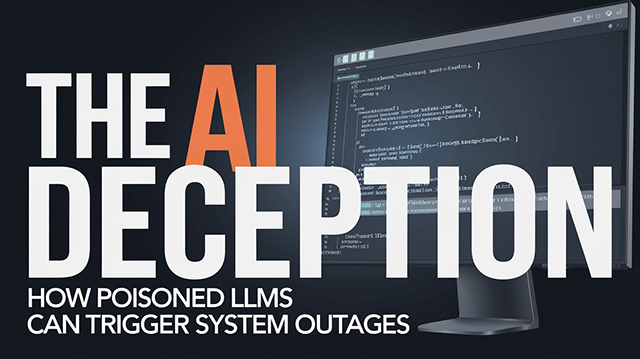The AI Deception: How Poisoned LLMs Can Trigger System Outages

Large Language Models (LLMs), a type of AI model, are rapidly changing the landscape of cybersecurity. These sophisticated algorithms can analyse vast amounts of data, identify patterns, and generate responses with remarkable accuracy. However, this reliance on AI also introduces new vulnerabilities. One of the most concerning is the potential for cybercriminals to poison AI LLMs with malicious Indicators of Compromise (IoCs), leading to the unintentional blocking of critical system files and subsequent system outages.
This threat reflects the early days of the internet, when scepticism and uncertainty were widespread. While the internet has undeniably brought about negative consequences, its benefits have far outweighed the risks. Similarly, AI LLMs offer immense potential for good, but we must approach their use with caution and common sense, always validating information that could have a negative impact.
Understanding the Threat
AI LLMs learn by analysing massive datasets, identifying patterns, and generating responses based on this training data. This learning process makes them susceptible to data poisoning attacks, where malicious actors inject false or misleading information into the training data. In the context of cybersecurity, this could involve introducing IoCs that appear malicious but actually correspond to critical system files.
Imagine an AI LLM trained on a dataset that has been subtly poisoned with malicious IoCs. When this LLM encounters a legitimate security advisory, it might misinterpret these IoCs as threats and recommend blocking them. If these IoCs correspond to essential system files, blocking them could lead to system instability, crashes, and even widespread outages.
Scenarios of Deception
Here are a few detailed scenarios where poisoned AI LLMs could be exploited to trigger system outages:
The Trusted Advisor
A cybercriminal, posing as a security researcher or a trusted source, releases a seemingly legitimate security advisory through channels like emails, blog posts, or security forums. This advisory, however, contains poisoned IoCs that point to critical system files, such as those associated with the operating system kernel, authentication services, or security software. Organisations relying on AI LLMs for threat intelligence might unknowingly incorporate this malicious advice into their security systems, leading to system disruptions. The attacker might leverage social engineering techniques like spear phishing to target specific individuals within an organisation and increase the likelihood of the poisoned advisory being accepted and acted upon.
The Compromised Dataset
A public dataset used to train AI LLMs is compromised by malicious actors. They inject poisoned IoCs into the dataset, which are then learned by the AI LLM. This compromised AI LLM could then be distributed through open-source repositories or other channels, potentially reaching a wide range of users. When these users employ the AI LLM for security analysis, it could misidentify legitimate files as threats, causing outages when those files are blocked. Attackers might also exploit vulnerabilities in APIs used to access or manage the dataset to inject poisoned data.
The Targeted Attack
An attacker specifically targets an organisation's AI LLM by feeding it poisoned data through various means, such as API calls or manipulated training data. This targeted attack could exploit vulnerabilities in the AI LLM's input validation or authentication mechanisms. By injecting carefully crafted data, the attacker could cause the AI LLM to misclassify critical files within the organisation's infrastructure, leading to targeted outages and potentially providing the attacker with further access to the compromised system. This type of attack could be particularly effective against organisations that use custom-trained AI LLMs for internal security operations.
Consequences of Poisoned AI LLMs
The consequences of poisoned AI LLMs can be far-reaching and severe:
- System Outages: Blocking critical system files can disrupt essential services, leading to downtime and operational disruptions. This can affect various sectors, including healthcare, finance, energy, and transportation, with potential cascading effects that impact public safety and national security.
- Financial Losses: System outages can result in lost productivity, revenue, and recovery costs. Organisations may face significant financial losses due to business interruption, data loss, and the need to restore systems and services.
- Reputational Damage: Organisations that fall victim to these attacks may suffer reputational damage due to service disruptions and security breaches. This can erode customer trust and have long-term consequences for the organisation's brand and image.
- Erosion of Trust: If AI LLMs are perceived as unreliable or vulnerable to manipulation, it could erode trust in AI-driven security tools. This could hinder the adoption of AI in cybersecurity and slow down progress in this critical field.
Mitigating the Risk
To mitigate the risk of poisoned AI LLMs, organisations should adopt a multi-layered approach that combines technical measures, user education, and robust security practices:
- Validate IoCs: Always cross-reference IoCs from multiple reputable sources before taking action. This includes verifying the source of security advisories and consulting with trusted security experts.
- Scrutinise Training Data: Implement robust data validation processes to ensure the integrity of training datasets. This includes using techniques like anomaly detection, data provenance tracking, and adversarial training to identify and mitigate potential poisoning attempts.
- Monitor AI LLM Behaviour: Continuously monitor AI LLM behaviour for anomalies or unexpected outputs. This can involve analysing logs, monitoring performance metrics, and using tools that can detect model drift or unusual behaviour.
- Employ Human Oversight: Combine AI with human expertise to ensure critical thinking and analysis. This includes having security analysts review AI LLM outputs, validate findings, and make informed decisions based on a combination of AI insights and human judgement.
- Develop Incident Response Plans: Have well-defined procedures for responding to security incidents caused by poisoned AI LLMs. This includes having a plan for containment, eradication, recovery, and post-mortem analysis to minimise damage and prevent future incidents.
- Educate Users: Educate users about the potential for AI LLM poisoning and the importance of validating information. This includes training employees to recognise social engineering tactics, phishing attempts, and other methods that attackers might use to spread poisoned IoCs.
- Promote a Culture of Cybersecurity Awareness: Foster a culture of cybersecurity awareness within the organisation. This includes encouraging employees to report suspicious activity, question unusual requests, and stay informed about the latest threats and vulnerabilities.
The Future of AI Security
As AI LLMs become more prevalent in cybersecurity, it is crucial to address the potential for data poisoning and other adversarial attacks. By understanding the threat, implementing robust security measures, and fostering a culture of vigilance, organisations can harness the power of AI while mitigating the risks. The future of AI security depends on a collaborative approach that combines human expertise with the capabilities of AI, ensuring that these powerful tools are used responsibly and effectively.


